The proposal from the government to temporarily hire international students who graduate from local higher education institutions in the electrical and electronics (E&E) industry, amid talent deficits within these sectors, is raising concerns about neglecting the needs of local graduates.
While international graduates could help bridge the workforce gap for the sector to sustain its competitiveness, it is equally important to provide equitable opportunities for local graduates to foster a skilled workforce and ensure its long-term growth trajectory.
Equal opportunity for local graduates in this sector will promote fairness and encourage the development of domestic talent, fostering a sense of ownership and commitment to the industry's advancement.
This approach not only contributes to the sector's immediate needs but also cultivates a sustainable pipeline of skilled professionals for future growth.
Foreign student work pass
Recently, a new proposal was introduced: Investment, Trade, and Industry Ministry (Miti) is considering allowing international students who graduate from Malaysian higher education institutions to work in the country.
This proposal was initially considered because of a reported increase in foreign direct investment in Malaysia, particularly from multinational companies, leading to a heightened demand for engineers - a demand that Malaysia's production of E&E graduates is failing to meet.
Our analysis delves into Graduate Tracer Study (GTS) datasets by the Higher Education Ministry (MOHE).
Interestingly, Miti has stated that our annual graduate output in the E&E sector averages only 5,000, falling short of the demand for 50,000 engineers driven by foreign direct investment.
According to GTS, Malaysia's total graduate output increased from 174,463 in 2010 to 286,299 in 2021, a rise of over 100,000 graduates in a decade (Figure 1).

Despite a slight dip in 2020, likely due to Covid-19 challenges, we are steadily returning to pre-pandemic levels. The field of E&E in the GTS is categorised into Electricity and Engineering, and Electronics and Automation, labelled collectively as E&E for ease of analysis.
What does the data say?
Our analysis will focus on graduates' distribution in the GTS dataset across qualification levels, ranging from diploma to postgraduate levels.
In 2021 alone, our total number of E&E graduates was 23,352 (Figure 2).
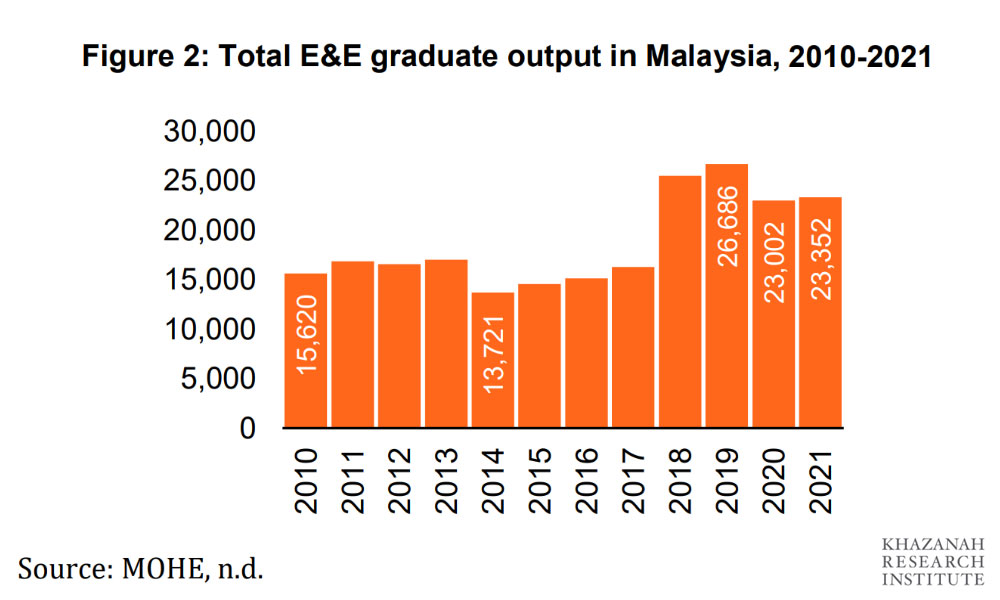
Across 12 years (since 2010), outputs from this field average out to 18,694 graduates yearly. There is already a discrepancy in numbers here; the minister claims in the same statement that Malaysian institutions only produce 5,000 E&E graduates a year, but the GTS has shown that the total number of E&E graduates is almost four times the figure mentioned.
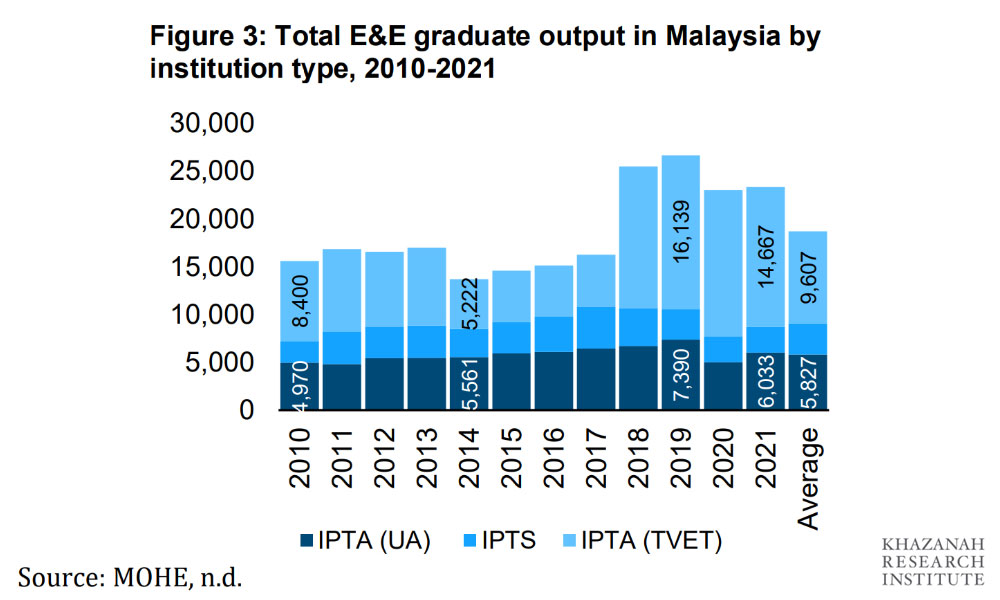
Figure 3 shows that when we break down the graduate output by study stream (and by extension, qualification level): the average output of IPTA E&E graduates is 5,827 per year, which is potentially consistent with the 5,000 figure mentioned by Miti.
They are correct in that around 5,000 graduates are output per year, but that is only referring to E&E graduates from public higher education institutions with degree qualifications and above, ignoring private universities.
The output of E&E TVET graduates on average is 9,607, almost double that amount. Even as we consider the difference in qualification type; that is a good 10,000 graduates underutilised if we take Miti’s statement at face value (Figure 4).
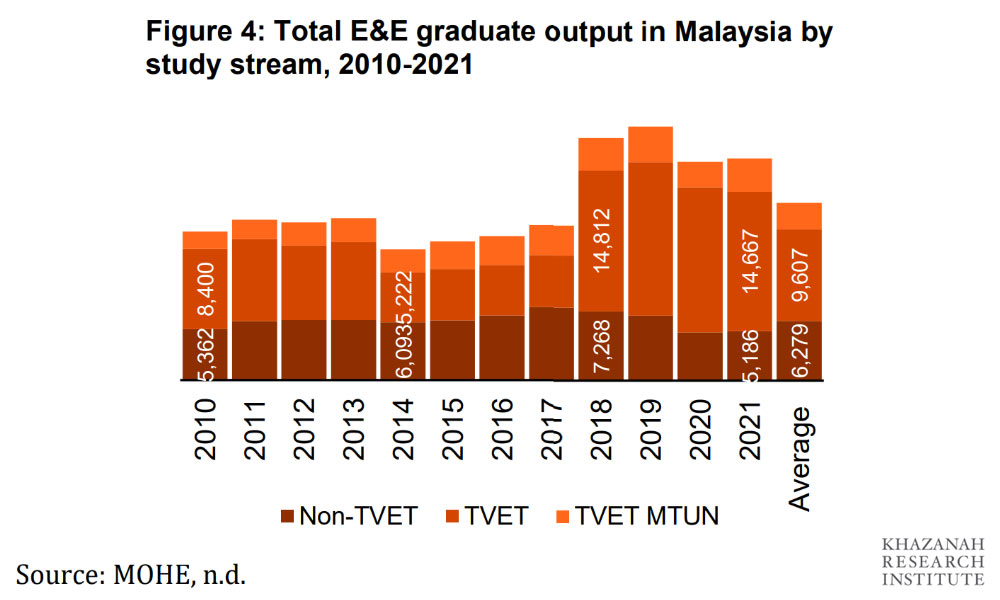
The underutilisation of the current graduate pool is also a major concern. The underutilisation occurs among graduates who experience vertical and horizontal mismatch.
Overqualification refers to vertical mismatch, where someone works in a job that requires less qualifications than they have. For example, a degree-holding graduate working as a delivery driver.
Field mismatch is a type of horizontal mismatch, referring to when graduates work in fields that do not match what they initially studied; think of a graduate who studied biotechnology working in copywriting.
When breaking down the number of overqualified E&E graduates, close to 1,000 E&E graduates (degree and above) are overqualified on average (Figure 5).
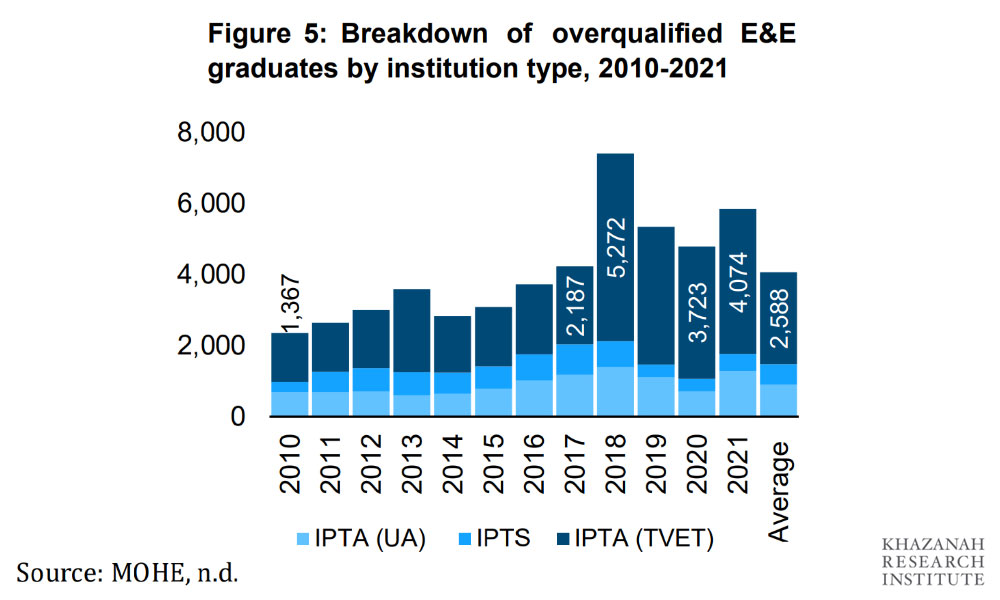
In 2021, we produced 6,033 E&E IPTA graduates and 1,276 of those graduates were overqualified: that was 20 percent of the total E&E graduate output that year.
When looking at horizontal mismatch, on the other hand, the numbers are not particularly different (Figure 6).
On average, 4,000 TVET graduates are working in fields unrelated to their studies per year, and the outcomes are slightly better for non-TVET graduates.
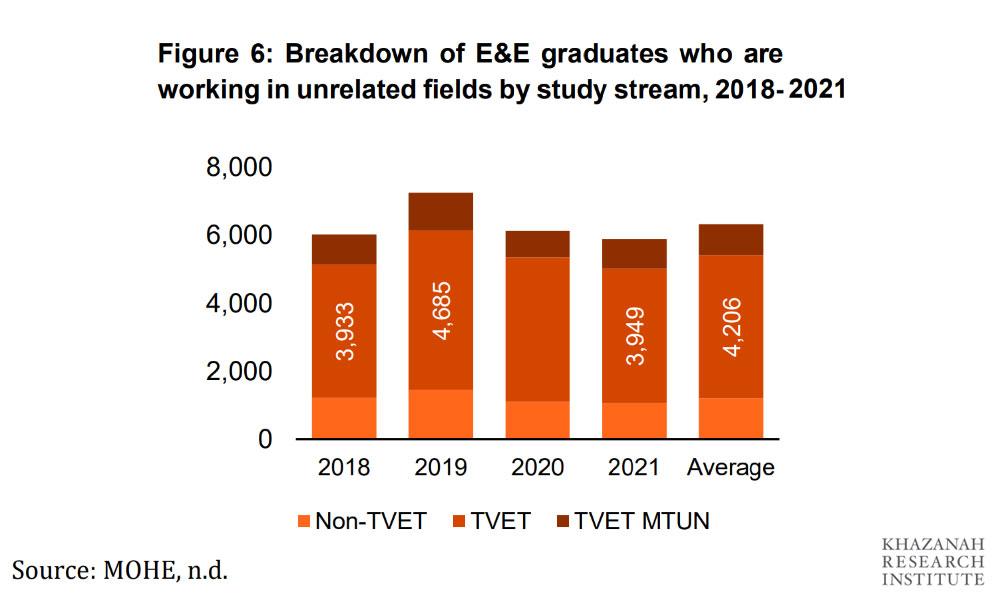
Horizontal and vertical mismatch represent a market loss through a loss of unique skillsets; a graduate is less likely to perform as well in a substitute role than a role they were trained to fill.
An engineer working as a barista is a labour market loss, as their engineering knowledge and expertise will eventually deteriorate and the national investment into their training results in a net loss.
A significant portion of the available talent pool is being underutilised and it prompts the question - why do we then need to consider recruiting more foreign graduates for this sector?
When looking at total job creation in the last six years as depicted from Figure 7, the E&E sector (represented by proxy of jobs in the production of electrical, electronics and optics) seems to have increased considerably; this aligns with the job creation focus on recent plans for the Malaysian economic outlook.
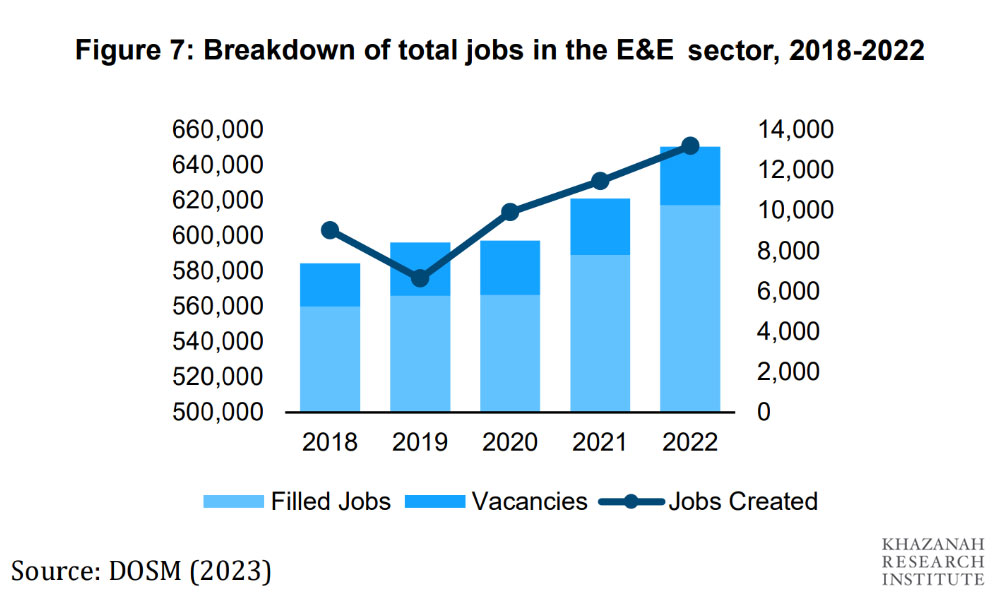
In Figure 8, we only include high-skilled jobs, and the trend is demonstrably worse off than the total jobs created. The graduate-level jobs proposed by Miti that we apparently cannot fill must be classified as high-skilled jobs, considering they require trained skilled talent from foreign graduates.
High-skill job creation has tapered down in the last six years and effectively plateaued. Vacancies have also been consistent throughout the years with filled jobs having a very minor increase - where are these apparent vacancies posted?
If we need over 50,000 engineers, will our Malaysian graduates be able to apply to these first, like the initial expat hiring requirement back in 2021?
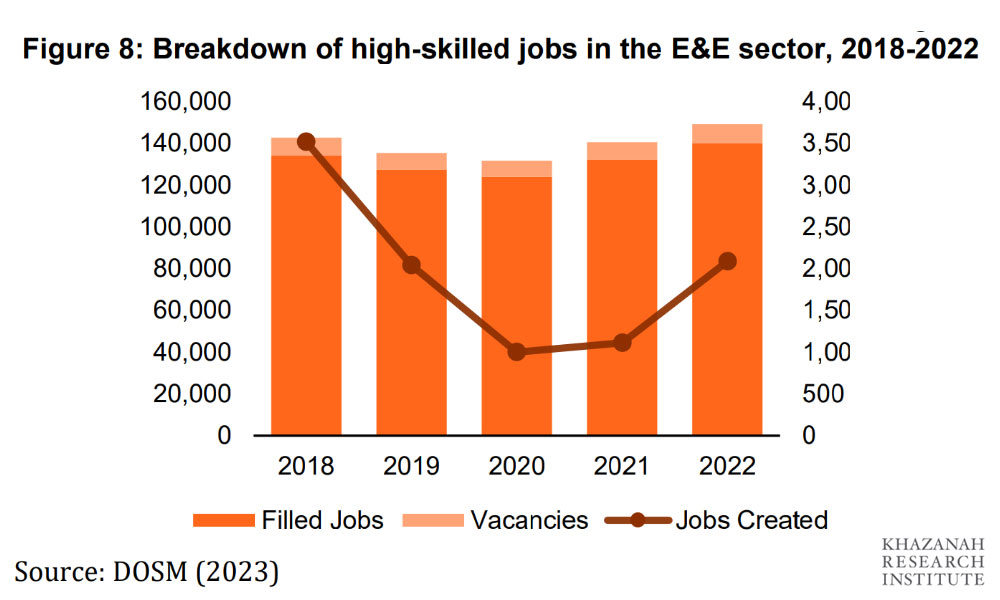
Three important questions
Our analysis brings us to three important questions on data-driven policy proposals:
Where are the numbers coming from?
What about TVET employability?
What is the intention of this proposal?
First, data transparency and data-driven decision-making must be at the forefront of any policy proposal. We are supportive of the proposal to bring in foreign graduates to bolster our workforce, given that the proposal is backed by a recognised need and deficit of available talent.
However, our own government-sourced statistics tell us that we have a lot of Malaysian talent being severely underutilised, especially those with TVET qualifications.
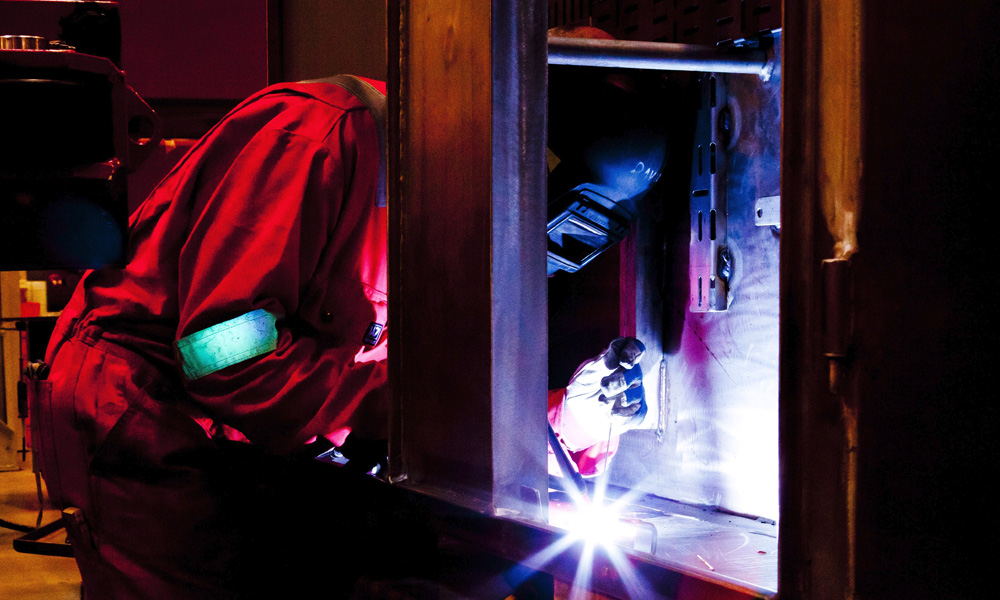
By outsourcing our skilled labour to foreign graduates first before utilising local talent, we are simply underutilising our local graduates.
Secondly, if TVET graduates are unable to rise to the challenge and meet the demand for E&E graduates, we must examine why.
The efficacy of the TVET syllabus has long been debated, with criticisms about its effectiveness and the capability of TVET graduates to apply their skills.
In fact, if we persist in favouring foreign talent over our own, we risk squandering our investment in the TVET sector. Therefore, if we are to implement this work pass as a temporary measure, it is imperative that we ensure our TVET curriculum is up to par.
Additionally, the recent proposal by the government to increase TVET graduates' salaries should be seen as an opportunity to meet the rising demand in the E&E sector and promote job creation.
Thirdly, the underlying intention of the proposed policy shift demands scrutiny. Are we aiming to supplement our local skilled workforce with international talent, or is there an implicit intention to substitute local talent with foreign workers?
Following the implementation of this policy, it is imperative to prioritise enhancing our local graduate capacity to reduce reliance on foreign labour.
This move is crucial to avoid replicating past practices of outsourcing unskilled labour at lower wage levels, which can undermine our workforce's long-term sustainability and economic resilience.
Recommendations and reconsiderations
Before implementing a foreign student work pass, the government should prioritise enhancing education quality by aligning the curriculum with industry needs, promoting hands-on experience through quality internships, and fostering lifelong learning.
Strengthening industry-academia partnerships, like the 2u2i programme, and establishing robust industry relationships can bridge the gap between academia and industry needs, ensuring that graduates are well-prepared for the workforce.
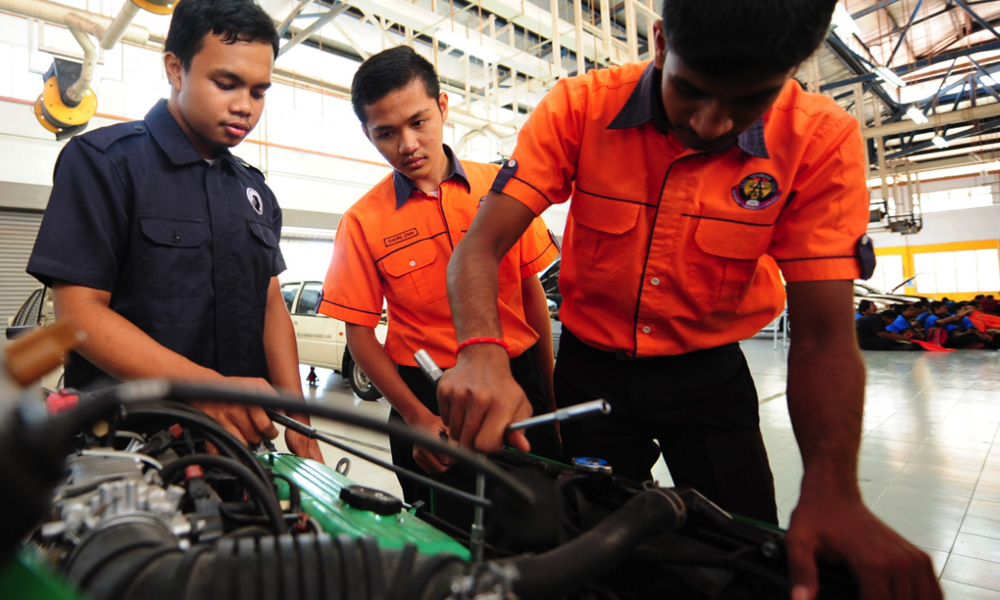
Additionally, offering competitive salaries and benefits to both local and foreign talents is crucial to attracting and retaining talent.
Local talents should receive equitable compensation compared to foreign counterparts to maintain a fair and sustainable workforce.
Furthermore, strengthening initiatives such as facilitating job placements, mentorship programmes, and networking opportunities for local graduates is crucial.
Not only does this ensure a smoother transition into the workforce for local talent, but it also safeguards their interests amidst increasing competition for job opportunities.
By fostering an environment that nurtures and empowers local talent, Malaysia can better address the challenges of the evolving job market while promoting sustainable economic growth and prosperity for all.
Drawing insights from international precedents, such as Australia's Temporary Graduate Visa and Singapore's Work Holiday Pass, can inform Malaysia's strategies.
Australia's Temporary Graduate Visa allows recent graduates to work, study, and live in Australia temporarily after completing their studies, providing them with valuable work experience.
Singapore's Work Holiday Pass allows young people from certain countries to work and holiday in Singapore for up to six months, fostering cultural exchange and cross-border collaborations.
These policies offer temporary solutions with stringent regulations to prevent exploitation and ensure benefits for both the country and its citizens.
The ongoing trend is anticipated to persist, with additional countries projected to participate in a similar programme for post-study work passes.
As the competition for international students intensifies, those providing the most appealing opportunities will have a competitive advantage in attracting top talent.
By granting post-study work rights, countries are not only attracting skilled individuals but also investing in their future prosperity.
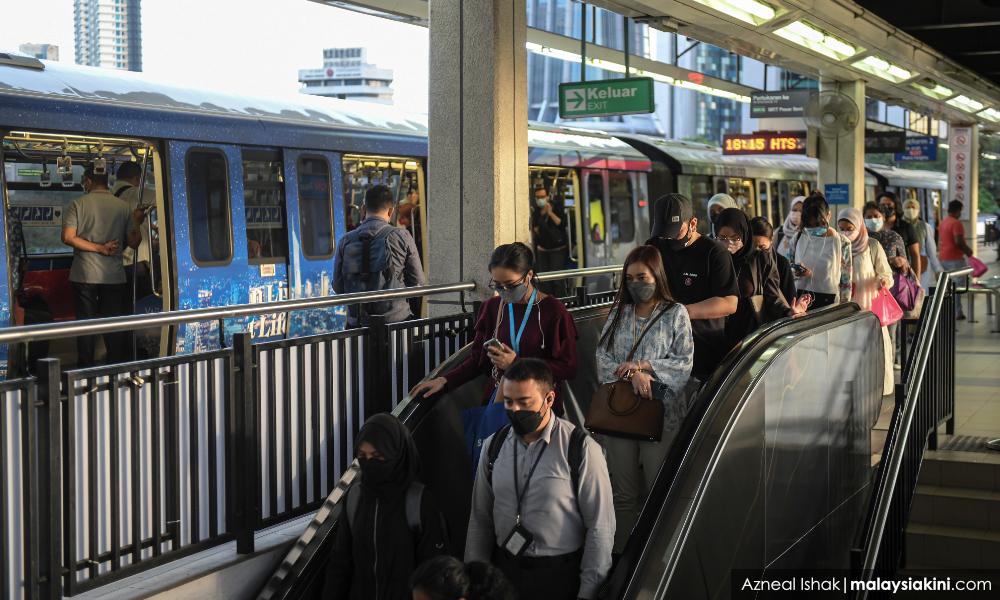
Malaysia can adopt similar policies with careful consideration to balance the needs of the economy with the well-being of its citizens, ensuring sustainable growth and development.
An important factor of the foreign graduate work pass is its “sunset clause” and implementation timeline. If this move is to supplement our workforce while we work on our graduate output capacity, then there must be a set point at which this policy is tampered down and eventually rolled back.
If this proposal only serves to substitute our graduate workforce for cheap skilled labour, then we have an entirely different problem on our hands. - Mkini
MOHD AMIRUL RAFIQ ABU RAHIM is a research associate at Khazanah Research Institute (KRI).
LAVENTHEN SIVASHANMUGAM is a former intern at KRI.
The views expressed here are those of the author/contributor and do not necessarily represent the views of MMKtT.



No comments:
Post a Comment
Note: Only a member of this blog may post a comment.